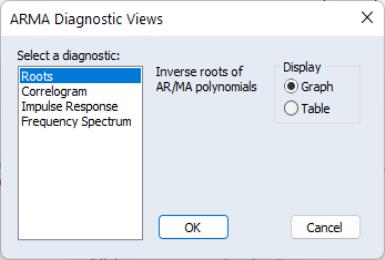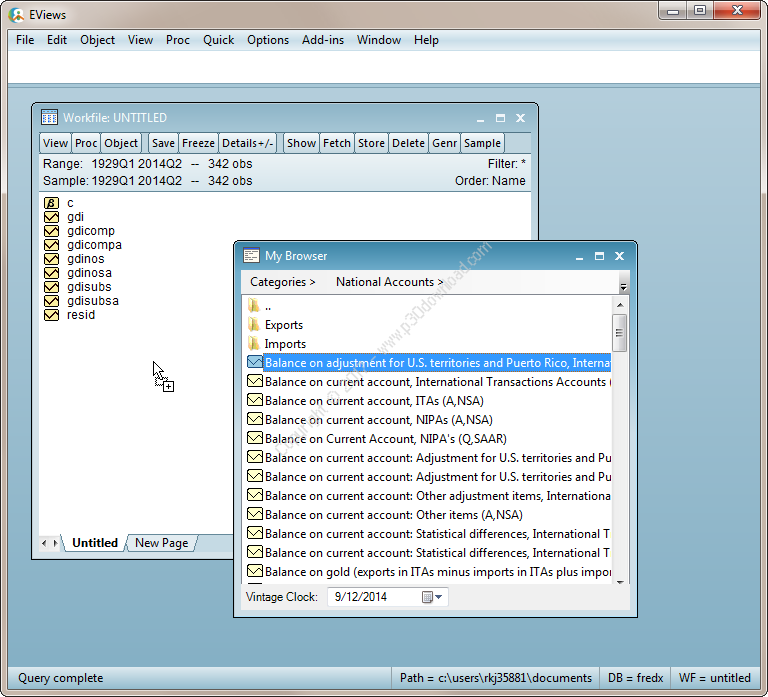

The new engine, which implements a sophisticated trust region approach (More and Sorensen, 1983), supports versions of the Broyden-Fletcher-Goldfarb-Shanno (BFGS), Gauss-Newton/BHHH, Newton-Raphson, and Fisher Scoring algorithms. We have integrated an all new estimation engine into many familiar EViews estimators. Among the applications of TR are models for sample splitting, multiple equilibria, and the very popular Threshold Autoregression (TAR) and self-exciting Threshold Autoregression (SETAR) specifications (Hansen 1999, 2011 Potter 2003). TR specifications are quite popular as they are easy to estimate and interpret, and able to produce interesting nonlinearities and rich dynamics. The Threshold Regression (TR) model describes a simple form of nonlinear regression with piecewise linear specifications and regime switching that occurs when an observed variable crosses unknown thresholds.

This class of model includes the popular threshold autogressive models (TAR). The PMG takes the cointegration form of the simple ARDL model and adapts it for a panel setting by allowing the intercepts, short-run coefficients and cointegrating terms to differ across cross-sections.ĮViews estimates threshold regression models (TR). This model is particularly popular in panel settings where the number of periods is large, since alternative GMM estimators may not be appropriate in those settings. Panel ARDL and Pooled Mean Group (PMG) EstimationĮViews now supports estimation of the Pooled Mean Group (PMG) estimator of Pesaran, Shin and Smith (PSS, 1999) for ARDL models with individual effects. Among the supported features are automatic intialization of the integration parameter d estimates using the Geweke and Porter-Hundlak (1983) log-periodogram regression, and concentration of the likelihood with respect to regression coefficients and scale. ARFIMAĮViews supports exact maximum likelihood estimation of ARFIMA models via ML or GLS using efficient algorithms as described in Sowell (1992) and Doornik and Ooms (2003). The use of the Kalman filter to evaluate the exact likelihood (Hamilton 1994). (in addition to the existing CLS-based estimator). ARDLs are standard least squares regressions which include lags of both the dependent variable and independent variables as regressors.īounds testing for long-run relationship.ĮViews now allows you to estimate ARMA models specified by list using ML and GLS We have a complete step-by-step demonstration of MIDAS using a paper by the Federal Reserve Bank of St Louis.ĮViews offers new tools for estimating and examining the properties of Autoregressive Distributed Lag (ARDL) models. EViews’ MIDAS implementation makes use of this easy handling of mixed frequencies to allow easy specification of MIDAS models.ĮViews allows 4 different MIDAS weighting schemes:īeta weights (with or without restrictions)ĮViews also offers automatic lag selection methods for determining the number of lags/periods of the higher frequency variables. A significant disadvantage to this approach is that through the aggregation you discard data which can lead to less accurate estimation.ĮViews workfiles natively support easy organization of mixed frequency data, and allow easy conversion from one frequency to another. Traditional approaches to dealing with the issue of mixed frequencies is to simply aggregate the higher frequency data into the lowest frequency.

Mixed-Data Sampling (MIDAS) is a method of estimating and forecasting from models where the dependent variable is recorded at a lower frequency than one or more of the independent variables. EViews 9.5 New Econometrics and Statistics: Estimation Mixed-Data Sampling (MIDAS) Regression


 0 kommentar(er)
0 kommentar(er)
